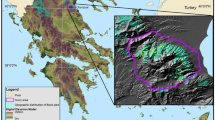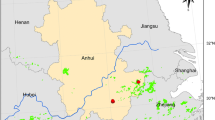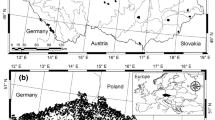Abstract
Height-to-diameter ratios (HD) are an important measure of the stability, density and competition of forest stands. It reflects the vertical growth of the trees, the vulnerability of the forest canopy structure and influences volumetric production. HD ratios vary according to tree size, availability of resources for growth, stand density and species composition. Data were taken from 210 trees and a regression technique of generalized linear models for the HD ratio applicable for forest structure conservation was developed. The objective of this study was to model the HD ratios of dominant and co-dominant trees of Araucaria angustifolia according to morphometric, dendrometric, annual diameter increment, stand density, and age variables in three sites in southern Brazil. The results show that the HD ratio decreases with increasing age, crown area and basal area, and increases with stand density and annual diameter increment. Accuracy of the developed equations was demonstrated by the values of deviation, Bayesian and Akaike criteria. The results are of interest to forest managers since they make decisions about silvicultural operations. Growth continuity and forest production indicate that any intervention should be directed at younger trees of smaller sizes, and that one of the main management factors for stand stability and growth is the formation of the stand and its capture of light.



Similar content being viewed by others
References
Adame P, Hynynen J, Cañellas I, del Río M (2008) Individual-tree diameter growth model for rebollo oak (Quercus pyrenaica Willd.) coppices. For Ecol Manag 255(3–4):1011–1022. https://doi.org/10.1016/j.foreco.2007.10.019
Albert M, Schmidt M (2010) Climate-sensitive modelling of site productivity relationship for Norway spruce (Picea abies [L.] Karst.) and common beech (Fagus sylvatica L.). For Ecol Manag 259:739–749. https://doi.org/10.1016/j.foreco.2009.04.039
Alvares CA, Stape JL, Sentelhas PC, Gonçalves JLM, Parovek G (2013) Köppen’s climate classification map for Brazil. Meteorol Z 22(6):711–728. https://doi.org/10.1127/0941-2948/2013/0507
Alves LF, Santos FAM (2002) Tree allometry and crown shape of four tree species in Atlantic rain forest, south-east Brazil. J Trop Ecol 18:245–260
Assmann E (1970) The principles of forest yield study. Pergamon, Oxford, p 506p
Barthélémy D, Caraglio Y (2007) Plant architecture: a dynamic multilevel and comprehensive approach to plant form, structure and ontogeny. Ann Bot 99:375–407. https://doi.org/10.1093/aob/mc1260
Beckert SM, Rosot MAD, Rosot NC (2014) Crescimento e dinâmica de Araucaria angustifolia (Bert.) O. Ktze. em fragmento de Floresta Ombrófila Mista. Sci For Piracicaba 42(102):209–218
Bošela M, Konôpka B, Šebeň V, Vladovič J, Tobin B (2014) Modelling height to diameter ratio—an opportunity to increase Norway spruce stand in the Western Carpathians. Lesn Cas For J 60:71–80
Brasil (2006) Decreto nº 11428, 22 de dezembro de 2006. Dispõe sobre a utilização e proteção da vegetação nativa do Bioma Mata Atlântica, e dá outras providências. Diário Oficial [da República Federativa do Brasil], Brasília (1)
Brasil (2008) Decreto nº 6514, de 22 de junho de 2008. Dispõe sobre as infrações e sanções administrativas ao meio ambiente, estabelece o processo administrativo federal para apuração destas infrações, e dá outras providências. Diário Oficial [da República Federativa do Brasil], Brasília (1)
Costa EA, Finger CAG, Fleig FD (2016) Influence of social position on the morphometrics relations in Araucaria angustifolia. Cienc Florest 26(1):225–234. https://doi.org/10.5902/1980509821116
Costa EA, Finger CAG, Hess AF (2018) Competition indices and their relationship with basal area increment of Araucaria. J Agric Sci 10(5):198–210. https://doi.org/10.5539/jas.v10n5p198
Eguakun FS, Oyebade BA (2015) Linear and nonlinear slenderness coefficient models for Pinus caribea (Morelet) stands in southwestern Nigeria. J Agric Vet Sci 8(3):26–30. https://doi.org/10.9790/2380-08322560
Forrester DI, Bauhus J (2016) A review of processes behind diversity–productivity relationships in forests. Curr For Rep 2:45–61
Forrester DI, Ammer C, Annighöfer PJ, Barbeito I, Bielak K, Oviedo AB, Coll L, del Río M, Drössler L, Heym M, Hurt V, Löf M, den Ouden J, Pach M, Pereira MG, Plaga BNE, Ponette Q, Skrzyszewski J, Sterba H, Svoboda M, Zlatanov TM, Pretzsch H (2018) Effects of crown architecture and stand structure on light absorption in mixed and monospecific Fagus sylvatica and Pinus sylvestris forests along a productivity and climate gradient through Europe. J Ecol 106:746–760
Hess AF, Loiola T, Souza IA, Nascimento B (2016) Morphometry of the crown of Araucaria angustifolia in natural sites in southern Brazil. Bosque 37(3):603–611. https://doi.org/10.4067/S0717-92002016000300017
Hess AF, Silveira AC, Krefta SM, Santos DV, Filho MDHV, Atanazio KA, Schorr LPB, Souza IA, Borsoi GB, Stepka TF, Costa EA, Liesenberg V (2018a) Crown dynamics of Brazilian pine (Araucaria angustifolia) in Santa Catarina region of Brazil. Aust J Crop Sci 12(3):449–457. https://doi.org/10.21475/ajcs.18.12.03.pne928
Hess AF, Loiola T, Souza IA, Minatti M, Ricken P, Borsoi G (2018b) Forest management for the conservation of Araucaria angustifolia in southern Brazil. Floresta 49(3):373–382. https://doi.org/10.5380/rf.v48i3.55452
Hess AF, Loiola TM, Minatti M, Rosa GT, Souza IA, Costa EA, Schorr LPB, Borsoi GA, Stepka TF (2018c) Morphometric relationships as indicative of silvicultural interventions for Brazilian pine in southern Brazil. J Agric Sci 10(7):110–121. https://doi.org/10.5539/jas.v10n7p110
Hess AF, Minatti M, Liesenberg V, Mattos PP, Braz EM, Costa EA (2018d) Brazilian pine diameter at breast height and growth in mixes Ombrophilous forest in Southern Brazil. Aust J Crop Sci 12(05):770–777. https://doi.org/10.21475/ajcs.18.12.15.PNE900
Hess AF, Ricken P, Ciarnoschi LD (2018e) Dendrochronology, increment and forest management in araucaria forest, Santa Catarina state. Ciênc Florest 28(4):1568–1582. https://doi.org/10.5902/1980509835104
Jucker T, Bouriand O, Coomes DA (2015) Crown plasticity enables trees to optimize canopy packing in mixed-species forests. Funct Ecol 29:1078–1086
Kaps M, Lamberson WR (2004) Biostatistics for animal science. CABI Publishing, London, p 459p
King D, Davies S, Supardi MN, Tan S (2005) Tree growth is related to light interception and wood density in two mixed dipterocarp forest of Malaysia. Funct Ecol 19:445–453
Lines ER, Zavala MA, Purves DM, Coomes DA (2012) Predictable changes in above ground allometry of trees along gradients of temperature, aridity and competition. Glob Ecol Biogeogr 21:1017–1028
MacFarlane DW, Kane B (2017) Neighbour effects on tree architecture: functional trade-offs balancing crown competitiveness with wind resistance. Funct Ecol 31:1624–1636. https://doi.org/10.1111/1365-2435.12865
Minatti M, Hess AF, Ricken P, Loiola TM, Souza IA (2016) Shape and size relationships of Araucaria angustifolia in South Brazil. Afr J Agric Res 11(41):4121–4127. https://doi.org/10.5897/AJAR2016.11220
MMA (2008) Ministério do Meio Ambiente. Instrução Normativa nº 6, de 23 de setembro de 2008. Reconhece espécies da flora brasileira ameaçadas de extinção e revoga a Portaria Normativa Ibama no 37- N, de 3 de abril de 1992. Diário Oficial [da República Federativa do Brasil], Brasília, 185(1), p 75
Pavlis M, Kane B, Harris JR, Seiler JR (2008) The effects of pruning on drag and bending moments of shade trees. Arboric Urban For 34:207–215
Rinntech® (2010) TSAP-WinTM: time series analysis and presentation for dendrochronology and related applications, vol 2. Rinntech, Heidelberg
SAS Institute (2011) The SAS system for Windows (Release 9.2). SAS Inst., Cary, NC
Schelhaas MJ (2008) The wind stability of different silvicultural systems for Douglas-fir in the Netherlands: a model-based approach. Forestry 81(3):399–414. https://doi.org/10.1093/forestry/cpn028
Schelhaas MJ, Kramer K, Peltola H, van der Werf DC, Wijdeven SMJ (2007) Introducing tree interactions in wind damage simulation. Ecol Model 207:197–209
Schöngart J, Piedade MTF, Wittmann F, Junk WJ, Worbes M (2005) Wood growth patterns of Macrolobium acaciifolim (Benth.) Benth. (Fabaceae) in Amazonian black-water floodplain forest. Oecologia 145:654–661
Silveira AC, Hess AF, Schorr LPB, Krefta SM, Santos DV, Filho MDHV, Atanazio KA, Costa EA, Stepka TF, Borsoi GA (2018) Management of Brazilian pine (Araucaria angustifolia (Bertol.) Kuntze) based on the Liocourt model in a mixed Ombrophilous forest in Southern Brazil. Aust J Crop Sci 12(02):311–317. https://doi.org/10.21475/ajcs.18.12.02.pne927
Sonego RC, Backes A, Souza AF (2007) Descrição da estrutura de uma Floresta Ombrófila Mista, RS, Brasil, utilizando estimadores não-paramétricos de riqueza e rarefação de amostras. Acta Bot Bras 21(4):943–955
Tsega M, Guadie A, Teffera ZL, Belayneh Y, Niu D (2018) Development and validation of height-diameter models for Cupressus lusitanica in Gergeda Forest, Ethiopia. For Sci Technol 14(3):138–144. https://doi.org/10.1080/21580103.2018.14827
Vieilleddent G, Courbaud B, Kunstler G, Dhôte JF, Clark JS (2010) Individual variability in tree Allometry determines light resource allocation in forest ecosystems: a hierarchical Bayesian approach. Oecologia 163:759–773. https://doi.org/10.1007/s00442-010-1581-9
Zhang X, Duan A, Zhang J, Xiang C (2014) Estimating tree height-diameter models with the Bayesian method. Sci World J 2014:1–9. https://doi.org/10.1155/2014/683691
Acknowledgements
The authors are grateful for the support of the Santa Catarina State University, Department of Forest Engineering and its Graduate Program. The FAPESC (Foundation for Research Support of the Santa Catarina State), Case Number 2017TR639, financial assistance for research groups and the owners of the Araucaria Forest for the availability of this study.
Author information
Authors and Affiliations
Corresponding author
Additional information
Publisher's Note
Springer Nature remains neutral with regard to jurisdictional claims in published maps and institutional affiliations.
Project funding: This study was supported The FAPESC (Foundation for Research Support of the Santa Catarina State), Case Number 2017TR639.
The online version is available at http://www.springerlink.com.
Corresponding editor: Yu Lei.
Rights and permissions
About this article
Cite this article
Hess, A.F., Minatti, M., Costa, E.A. et al. Height-to-diameter ratios with temporal and dendro/morphometric variables for Brazilian pine in south Brazil. J. For. Res. 32, 191–202 (2021). https://doi.org/10.1007/s11676-019-01084-8
Received:
Accepted:
Published:
Issue Date:
DOI: https://doi.org/10.1007/s11676-019-01084-8




